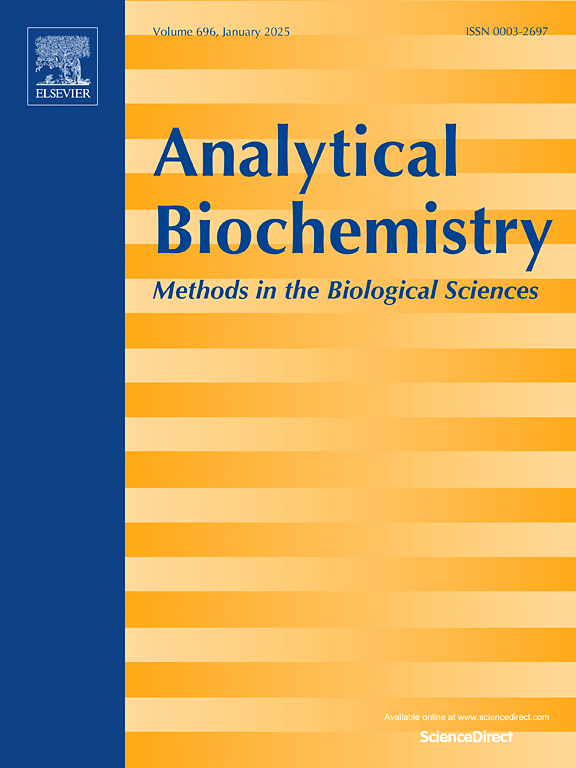Comparison of the techniques for isolating immunoassay-suitable proteins from heterogeneous fecal samples
IF 2.6
4区 生物学
Q2 BIOCHEMICAL RESEARCH METHODS
引用次数: 0
Abstract
Immunoassays could provide valuable insights into disease biomarkers and gut health by measuring fecal proteins. However, reliably isolating intact proteins from feces is challenging due to its heterogeneous and variable composition. This paper aims to review and compare different methods for extracting proteins from fecal samples to make them suitable for immunoassay analysis. Mechanical homogenization helps release proteins by disrupting solids, while protease inhibitors preserve protein integrity. Detergents like SDS solubilize proteins by disrupting hydrophobic interactions. Organic solvents such as acetone precipitate proteins and remove contaminants. Thermal treatment denatures proteases. Immunocapture uses antibodies to purify target proteins away from interference selectively. Commercial kits contain optimized buffers but may be cost-prohibitive. Combining mechanical, chemical, and immunological techniques synergistically integrates their advantages, improving the recovery of native proteins with reduced matrix effects. While all methods have merits, tailored protocols integrating multiple mechanisms appear most promising for extracting immunoassay-suitable fecal proteins. Further optimization and standardization of such combination approaches matched to proteins and assays of interest helps expand noninvasive fecal proteome analysis.

从异种粪便样品中分离免疫测定适宜蛋白的技术比较。
免疫分析可以通过测量粪便蛋白质,为疾病生物标志物和肠道健康提供有价值的见解。然而,从粪便中可靠地分离完整的蛋白质是具有挑战性的,因为它的异质性和可变的组成。本文旨在综述和比较从粪便样品中提取蛋白质的不同方法,使其适用于免疫分析。机械均质通过破坏固体帮助释放蛋白质,而蛋白酶抑制剂保持蛋白质的完整性。像SDS这样的洗涤剂通过破坏疏水相互作用来溶解蛋白质。有机溶剂如丙酮沉淀蛋白质和去除污染物。热处理使蛋白酶变性。免疫捕获利用抗体选择性地纯化目标蛋白,使其远离干扰。商业套件包含优化的缓冲,但可能成本过高。结合机械、化学和免疫学技术,协同整合它们的优势,提高天然蛋白质的回收率,减少基质效应。虽然所有方法都有优点,但整合多种机制的定制方案似乎最有希望提取适合免疫测定的粪便蛋白。进一步优化和标准化这些与蛋白质和检测相匹配的组合方法有助于扩展无创粪便蛋白质组分析。
本文章由计算机程序翻译,如有差异,请以英文原文为准。
求助全文
约1分钟内获得全文
求助全文
来源期刊

Analytical biochemistry
生物-分析化学
CiteScore
5.70
自引率
0.00%
发文量
283
审稿时长
44 days
期刊介绍:
The journal''s title Analytical Biochemistry: Methods in the Biological Sciences declares its broad scope: methods for the basic biological sciences that include biochemistry, molecular genetics, cell biology, proteomics, immunology, bioinformatics and wherever the frontiers of research take the field.
The emphasis is on methods from the strictly analytical to the more preparative that would include novel approaches to protein purification as well as improvements in cell and organ culture. The actual techniques are equally inclusive ranging from aptamers to zymology.
The journal has been particularly active in:
-Analytical techniques for biological molecules-
Aptamer selection and utilization-
Biosensors-
Chromatography-
Cloning, sequencing and mutagenesis-
Electrochemical methods-
Electrophoresis-
Enzyme characterization methods-
Immunological approaches-
Mass spectrometry of proteins and nucleic acids-
Metabolomics-
Nano level techniques-
Optical spectroscopy in all its forms.
The journal is reluctant to include most drug and strictly clinical studies as there are more suitable publication platforms for these types of papers.
 求助内容:
求助内容: 应助结果提醒方式:
应助结果提醒方式:


